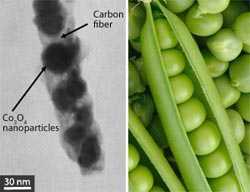Nanomaterials: Peapod power

Cobalt oxide nanoparticles embedded in carbon fibers (left) to form peapod-like structures improve the lifetime of electrodes in lithium-ion batteries. <br>Copyright : Left: 2010 ACS. Right: iStockphoto.com/pixhook <br>
Lithium-ion batteries are used to power a wide range of electronic devices, including computers, cameras, digital audio players and calculators. Tremendous effort has been devoted to the development of lithium-ion batteries, especially in improving the efficiency and integrity of the battery electrodes.
This is because during the discharging and charging processes, lithium ions are repeatedly incorporated into and extracted from the electrodes by alloy formation or chemical conversion. These recurring events are known to cause the progressive degradation of the electrodes, irreversibly damaging battery performance.
Yu Wang at the A*STAR Institute of Chemical and Engineering Sciences and co-workers[1] have now demonstrated an elegant strategy to reduce the degradation problem and increase the capacity retention of lithium-ion batteries over many charge–discharge cycles. The strategy involves the use of a composite material with a peapod structure comprising cobalt oxide (Co3O4) nanoparticles embedded in carbon fibers (see image).
Cobalt oxide is a promising material for anodes in lithium-ion batteries because its capacity for holding ions is higher than that of conventional electrode materials, such as tin. In addition, Co3O4 can be easily converted to LiCoO2, which is the material currently used in commercial cathodes. The researchers made the peapod structures by heating cobalt carbonate hydroxide nanobelts coated with layers of polymerized glucose in an inert atmosphere at 700 ºC and then in air at 250 ºC. Electrodes built using the peapod composite had enhanced lithium storage and capacity retention—delivering 91% of the total possible capacity after 50 charge–discharge cycles.
“The Co3O4 nanoparticles act as active materials to store lithium ions and the hollow carbon fibers protect and prevent the Co3O4 nanoparticles from aggregating and collapsing,” says Wang. The carbon fibers also play the role of conducting electrons from the nanoparticles.
According to Wang, aside from the promising application in lithium-ion batteries, the fabrication of the peapod composite is an achievement in itself, as it is the first time that such isolated magnetic nanoparticles embedded in hollow fibers have been produced. Scanning electron microscopy revealed that the peapod composite exhibits a uniform morphology, with pod lengths of up to several micrometers and pod diameters of as small as 50 nanometers. The researchers believe that their method could be extended to generate encapsulated nanoparticles using a wide range of materials with applications beyond lithium-ion batteries, for example, in gene engineering, catalysis, gas sensing and the manufacture of capacitors and magnets.
The A*STAR-affiliated researchers contributing to this research are from the Institute of Chemical and Engineering Sciences.
Journal information
[1] Wang, Y. et al. Designed functional systems from peapod-like Co@carbon to Co3O4@carbon nanocomposites. ACS Nano 4, 4753–4761 (2010).
Media Contact
All latest news from the category: Materials Sciences
Materials management deals with the research, development, manufacturing and processing of raw and industrial materials. Key aspects here are biological and medical issues, which play an increasingly important role in this field.
innovations-report offers in-depth articles related to the development and application of materials and the structure and properties of new materials.
Newest articles

Going Steady—Study Reveals North Atlantic’s Gulf Stream Remains Robust
A study by the University of Bern and the Woods Hole Oceanographic Institution in the USA concludes that the ocean circulation in the North Atlantic, which includes the Gulf Stream,…

Single-Celled Heroes: Foraminifera’s Power to Combat Ocean Phosphate Pollution
So-called foraminifera are found in all the world’s oceans. Now an international study led by the University of Hamburg has shown that the microorganisms, most of which bear shells, absorb…

Humans vs Machines—Who’s Better at Recognizing Speech?
Are humans or machines better at recognizing speech? A new study shows that in noisy conditions, current automatic speech recognition (ASR) systems achieve remarkable accuracy and sometimes even surpass human…



